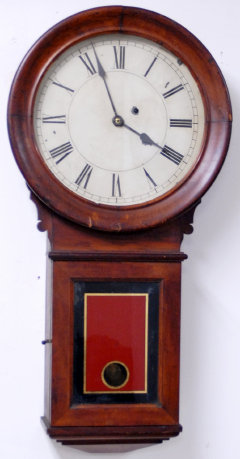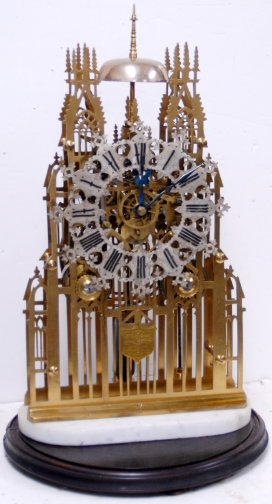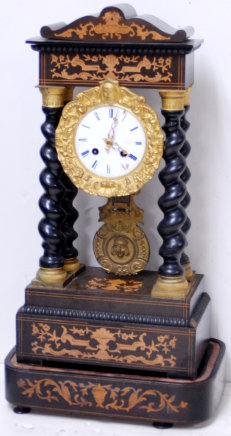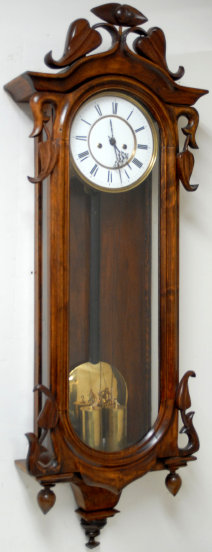

92. $350
French Empire-style Portico clock in an ebonized case with
gilt bronze capitals and pendulum, and good marquetry inlay over the case and bases including the bed of the case under the pendulum. There are four twisted columns. Decorative cast brass pendulum hanging on the back of the round French 8-day movement. The movement is not signed; it is a typical French round movement, outside count wheel, and bell strike on half hours and hours. The case on the base is about 21 ½ inches tall. Cast brass sash around the one-piece porcelain dial and it has nice French
hands. The dial is signed but I cannot read the name. It also has chips, chip repairs, and hairlines. $400-$600.

93. $2000
English large cathedral style skeleton clock, ca 1875. Gothic Roman numeral silvered dial with heart form piercing and scalloped edges, and blued steel hands. The movement is
8-day time and strike, double chain fusee, passing strike on a silver bell on the half hours and counting the hours on a large coil
gong. There is a presentation plaque on the front showing the clock was presented to “Mr. Thomas Holden / Victoria Mill,
Baxenden”, a town in northwest England. The clock on the base, without the dome, is 24 inches tall. With the dome in place
it is 27 inches tall. An identical clock by the same maker, without a glass dome and a replaced base, sold at Schmitt’s May
2015 auction for $3600 plus 15%. $2500-$3500.
91. $500
E. Howard & Co. Boston, “Regulator No. 70”, ca
1882. Near original example of a fine wall clock. The original painted dial is dirty looking and should clean for there
is very little paint loss. The movement is signed “E. Howard & Co. / Boston / 59”. The walnut case is original,
nicks on the bezel to tint, crusty around the case otherwise and needs to be cleaned and polished. There is minimal smoke remaining
in the cracks and crevices. The 8-day movement, pendulum stick, pendulum bob, pendulum, weight, weight pulley, hands, and special
Howard door latches, are all good stock. The baffle board over the weight is missing as is part of the pendulum tie down. This
is a pretty rough example but with work can be a nice clock again. Ly-American Clocks, Volume 1, page 123. $750-$1000.

90. $750
Seth Thomas Clock Co. wall clock, “Umbria”, ca 1897. The
factory date is stamped on the back, “7981”. Oak case is 40 ½” high, has probably never been cleaned as there are still remnants
of aged paint over the case and in the grooves and joints. Both glasses are old, two door locks on the side, original painted
dial with some wear, smudges, and tiny chips. It has three incorrect hands, original brass bob, wood stick, and brass beat scale. The brass movement is double spring, 15-day time only. Nice correct clock with a heavy-duty movement that should give
you a lifetime of good service one you clean and polish the case. Ly-Seth Thomas, page 320. Booked for $2000 a few years
ago. $1000-$1500.



88. $500
Three Weight, Grand Sonnerie, Vienna Regulator, ca 1875. Brass movement is not signed but the dial is signed with a name and address that is partly worn and hard to read. Double
coil gongs on the back of the movement that sound the quarters and hours. Called a “Blind Man’s Clock”, because when it strikes
quarter hours and hours during the night you know what time it is. It strikes one time 15 minutes after the hour, then strikes
the number of the last hour. At 30 minutes past the hour it strikes two times on one gong, and the number of the last hour on
the other gong, etc. The two-piece porcelain dial has some light hairlines, and it has a great pair of Vienna hands. The
movement bracket is wood and the movement slides down into the bracket. Polished brass pendulum bob, porcelain beat scale, three
matching brass weights, three matching brass pulleys, and a winding crank. The 63” walnut case is near perfect, it has carved
half columns on the door, an eagle top that I was not able to photograph on the clock because of the clock size. The case
has been cleaned and polished. The walnut finish has been rubbed, now with a slick furniture like finish. Picture frame
on the backboard with a darker walnut wood insert. There are three good glasses, wall levelers, and a door latch. This
is probably the largest Vienna I have had in my 45 years selling. $750-$1000.

89. $500
Lenzkirsch 2 weight Vienna Regulator, ca 1870. This
style with elaborately turned pieces on the door, top and base, are rarely seen on Vienna cases. The walnut case is about 44
inches tall. The wood parts including top and finials appear to be original to the case. It has the typical three glasses
and wall levelers are in place. The 8-day brass movement is held to a brass back plate with thumb screws, coil gong is attached
to the movement, and the pendulum attaches to the case back. The movement is signed “Lenzkirsch / 240448”. The good two-piece
dial is unsigned. The old hands are of the period and the porcelain dial is very good but does have minute hairlines
around the nine. It has a nice pair of brass weights, brass pendulum ball, and brass dial rings is all in original condition
and have been polished. Below the pendulum is porcelain beat scale. A very nice Vienna needing only a good home. $750-$1000.